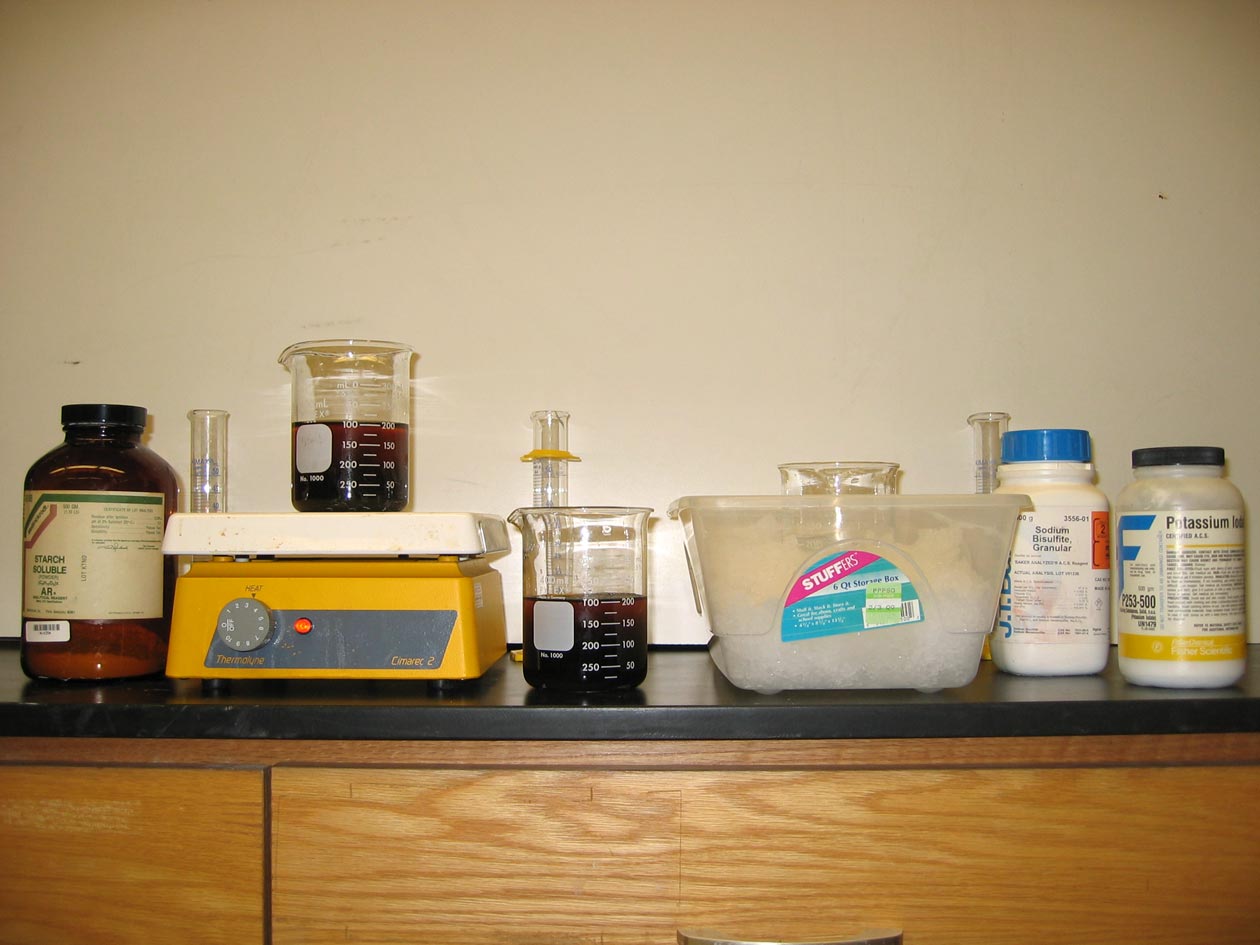Exploring the temperature dependence of reaction rates using the Landolt "iodine clock" reaction
 The iodine "clock" reaction is run at a three temperatures to observe the dependence of the reaction time on the temperature of the reaction solution.
The iodine "clock" reaction is run at a three temperatures to observe the dependence of the reaction time on the temperature of the reaction solution.
Ingredients: sodium bisulfite, potassium iodate, starch
Procedure: A complete recipe follows.
1. Prepare solutions of sodium thiosulfate.
2. Prepare solutions of starch and combine with solution of sodium thiosulfate.
3. Prepare solution of potassium iodate.
4. Add solution of potassium iodate to sodium sulfate and starch solution.
5. Measure reaction time.
6. Repeat reaction for solutions thermally equilibrated in ice water, and heated to near boiling.
Understanding: This reaction is a well known example of the so-called "clock reactions" where a reaction displays a clear "endpoint" that appears after a well-defined amount of time. In the iodine clock reaction, the overall reaction process is described by the following mechanism
IO3-(aq) + 3 HSO3-(aq) → I-(aq) + 3 SO42-(aq) + 3 H+(aq)
IO3-(aq) + 8 I-(aq) + 6 H+(aq) → 3 I3-(aq) + 3 H2O(l)
I3-(aq) + HSO3-(aq) + H2O(l) → 3 I-(aq) + SO42-(aq) + 3 H+(aq)
2 I3-(aq) + starch → starch blue-I5-(aq) + I-(aq)
When any mechanism is proposed, the steps in the mechanism must sum to the overall reaction as required by the law of mass action. For the mechanism above the overall reaction is2 IO3-(aq) + 3 I-(aq) + 4 HSO3-(aq) → starch blue-I5-(aq) + 2 H2O(l) + 4 SO42-(aq)
representing a conversion of the reactants iodate and hydrogen sulfite to products water, sulfate, and a deep blue starch-pentaiodide complex.Our demonstration explored the rate of the reaction at three different temperatures: ice water, 0C, room temperature, 22C, and near boiling water, 80C. It was observed that the reaction run at the lowest temperature occurred in the longest time, while the reaction run at the highest temperature occurred in the shortest time.
Rates of reaction show an exponential temperature dependence
We can understand this observation at the molecular level. Kinetic theory provides us with an accurate estimate of the distribution of speeds of the molecules. The average speed of a molecule of mass M at temperature T is
uave = (8RT/πM)1/2
probability of having velocity v = constant x exp[-Ekinetic/RT]
Consider an elementary chemical reaction. If the reaction requires energy to occur, an energetic barrier must be overcome. When the energy barrier to reaction is high, the probability of molecules gaining sufficient energy to react can be quite small.
It can be show that the rate of reaction for an elementary process will vary as
rate of reaction = constant x exp(-Eact/RT)
Experimental determination of the activation energy
As the temperature is increased, the thermal energy "RT" will increase making the ratio of the activation energy to the thermal energy, Eact/RT, smaller. That means that the reaction rate will be larger and the reaction time will be smaller. Increasing the temperature will increase the rate of reaction.
This leads to a useful result. If we measure the reaction rate at two temperatures, k(T2) and k(T1), we can use the result to determine the activation energy of the reaction
ln[ k(T2)/k(T1)] = (Eact/R) (1/T1 - 1/T2)
You can check your answers here.
Temperature dependence of chemical reaction rates
Question:
A chemical reaction is run at 20C, and a reaction time is observed. When the temperature of a reaction solution is increased by 25C, the reaction time is reduced by a factor of two. What is the activation energy of the reaction?